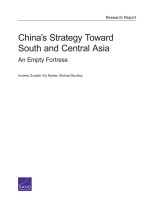| 来源类型 | Report
|
| 规范类型 | 报告
|
| 来源ID | RR-525-AF
|
| China's Strategy Toward South and Central Asia: An Empty Fortress |
| Andrew Scobell; Ely Ratner; Michael Beckley
|
| 发表日期 | 2014-08-11
|
| 出版年 | 2014
|
| 语种 | 英语
|
| 结论 | Four Drivers of China's Central Asia Policy - Beijing is consumed by insecurity and the goals of ensuring domestic stability and protecting national unity. China is especially preoccupied with suppressing internal unrest among ethnic minorities in its western regions.
- Beijing is driven to maintain peace, predictability, and secular governments in the countries of Central Asia, as it fears linkups between internal challenges and external threats, notably the Uighur Diaspora that spills across national borders.
- China seeks to increase influence in Central Asia and thereby limit the influence of other powers.
- China seeks to promote its economic interests in Central Asia and enhance energy security.
China's Relations with Afghanistan and Pakistan - China has friendly relations with Afghanistan and has become the largest investor in the country, but it has been a bystander to Western military activities in the country.
- Pakistan is probably China's closest and most enduring ally of the past half-century, but its strategic importance to China has decreased since the end of the Cold War.
- The future of Chinese influence in both these countries is uncertain.
China's Empty Fortress Strategy and Its Implications for the United States- China's westernmost regions are poorly defended and vulnerable to internal dissent and external threats. China has boldly projected an image of considerable strength in in these regions to mask serious frailty — known as an "Empty Fortress" stratagem in the annals of Chinese history.
- China's Empty Fortress strategy is exemplified by its promotion of the Shanghai Cooperation Organization (SCO), which consists of China, Kazakhstan, Kyrgyzstan, Russia, Tajikistan, and Uzbekistan. The SCO gives the outward appearance of potency and activism but is in fact a loose collection of states incapable of resolute collective action.
- Currently, China is not a major threat to U.S. interests in Central Asia, Afghanistan, or Pakistan and is unlikely to pose one in the near future.
|
| 摘要 | This study analyzes what is driving China's Central Asia and Afghanistan-Pakistan policies, identifies China's overarching strategy, examines the extent of Chinese activities in the region, and assesses their implications for the United States. The authors contend that China's response to the complex challenges on its western borders during the past two decades has been to adopt an "Empty Fortress" strategy, whereby China boldly projects an image of considerable strength in Central and South Asia to mask serious frailty. They conclude that China is not a major threat to U.S. interests in Central Asia, Afghanistan, or Pakistan and is unlikely to pose one in the near future. |
| 目录 |
Chapter One
Introduction
Chapter Two
What Is Driving China's Central Asia Policy?
Chapter Three
China's Central Asia Strategy
Chapter Four
China in Afghanistan and Pakistan
Chapter Five
China's Empty Fortress and U.S. Strategy
|
| 主题 | Afghanistan
; Central Asia
; China
; Global Security
; International Diplomacy
; International Economic Relations
; Pakistan
; United States
|
| URL | https://www.rand.org/pubs/research_reports/RR525.html
|
| 来源智库 | RAND Corporation (United States)
|
| 资源类型 | 智库出版物
|
| 条目标识符 | http://119.78.100.153/handle/2XGU8XDN/522539
|
推荐引用方式
GB/T 7714 |
Andrew Scobell,Ely Ratner,Michael Beckley. China's Strategy Toward South and Central Asia: An Empty Fortress. 2014.
|
|
文件名:
|
RAND_RR525.pdf
|
|
格式:
|
Adobe PDF
|
|
文件名:
|
1495316362678.jpg
|
|
格式:
|
JPEG
|

除非特别说明,本系统中所有内容都受版权保护,并保留所有权利。
